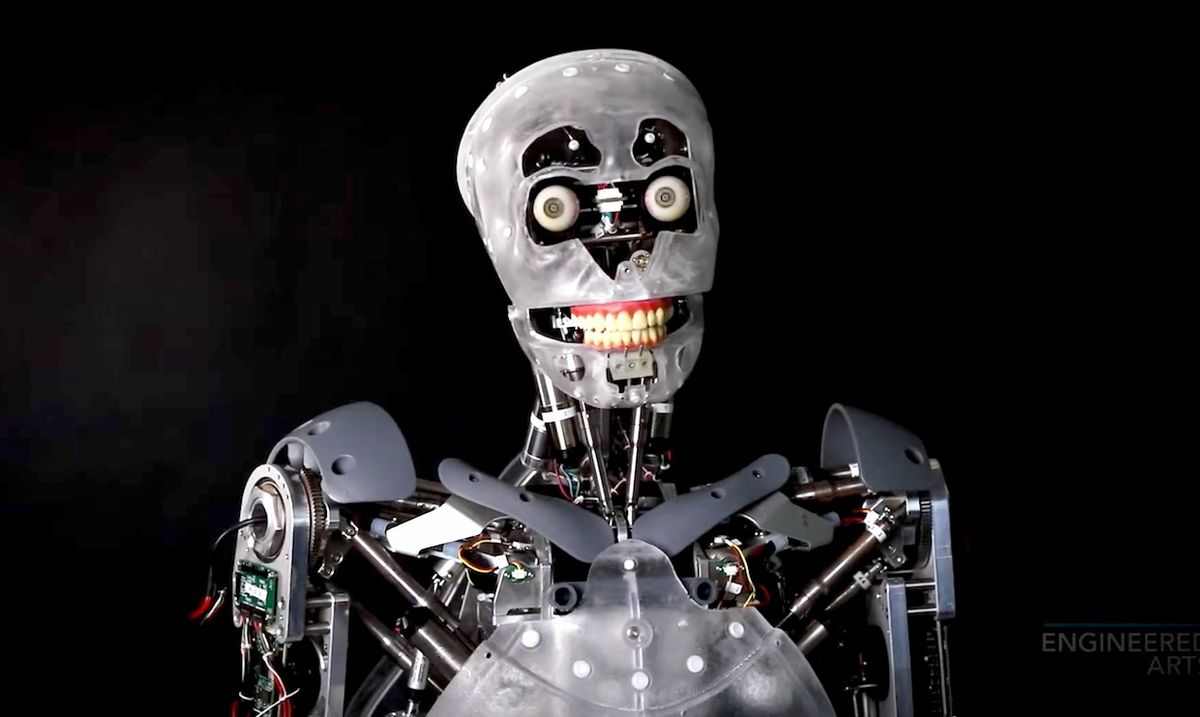Video Friday is your weekly selection of awesome robotics videos, collected by your Automaton bloggers. We’ll also be posting a weekly calendar of upcoming robotics events for the next few months; here’s what we have so far (send us your events!):
AUVSI EXPONENTIAL 2020 – October 5-8, 2020 – [Online]
IROS 2020 – October 25-29, 2020 – [Online]
ROS World 2020 – November 12, 2020 – [Online]
CYBATHLON 2020 – November 13-14, 2020 – [Online]
ICSR 2020 – November 14-16, 2020 – Golden, Colo., USA
Let us know if you have suggestions for next week, and enjoy today’s videos.
Bear Robotics, a robotics and artificial intelligence company, and SoftBank Robotics Group, a leading robotics manufacturer and solutions provider, have collaborated to bring a new robot named Servi to the food service and hospitality field.
[ Bear Robotics ]
A literal in-depth look at Engineered Arts’ Mesmer android.
[ Engineered Arts ]
Is your robot running ROS? Is it connected to the Internet? Are you actually in control of it right now? Are you sure?
I appreciate how the researchers admitted to finding two of their own robots as part of the scan, a Baxter and a drone.
[ Brown ]
Smile Robotics describes this as “(possibly) world’s first full-autonomous clear-up-the-table robot.”
We’re not qualified to make a judgement on the world firstness, but personally I hate clearing tables, so this robot has my vote.
Smile Robotics founder and CEO Takashi Ogura, along with chief engineer Mitsutaka Kabasawa and engineer Kazuya Kobayashi, are former Google roboticists. Ogura also worked at SCHAFT. Smile says its robot uses ROS and is controlled by a framework written mainly in Rust, adding: “We are hiring Rustacean Roboticists!”
[ Smile Robotics ]
We’re not entirely sure why, but Panasonic has released plans for an Internet of Things system for hamsters.
We devised a recipe for a "small animal healthcare device" that can measure the weight and activity of small animals, the temperature and humidity of the breeding environment, and manage their health. This healthcare device visualizes the health status and breeding environment of small animals and manages their health to promote early detection of diseases. While imagining the scene where a healthcare device is actually used for an important small animal that we treat with affection, we hope to help overcome the current difficult situation through manufacturing.
[ Panasonic ] via [ RobotStart ]
Researchers at Yale have developed a robotic fabric, a breakthrough that could lead to such innovations as adaptive clothing, self-deploying shelters, or lightweight shape-changing machinery.
The researchers focused on processing functional materials into fiber-form so they could be integrated into fabrics while retaining its advantageous properties. For example, they made variable stiffness fibers out of an epoxy embedded with particles of Field’s metal, an alloy that liquifies at relatively low temperatures. When cool, the particles are solid metal and make the material stiffer; when warm, the particles melt into liquid and make the material softer.
[ Yale ]
In collaboration with Armasuisse and SBB, RSL demonstrated the use of a teleoperated Menzi Muck M545 to clean up a rock slide in Central Switzerland. The machine can be operated from a teloperation platform with visual and motion feedback. The walking excavator features an active chassis that can adapt to uneven terrain.
[ ETHZ RSL ]
An international team of JKU researchers is continuing to develop their vision for robots made out of soft materials. A new article in the journal "Communications Materials" demonstrates just how these kinds of soft machines react using weak magnetic fields to move very quickly. A triangle-shaped robot can roll itself in air at high speed and walk forward when exposed to an alternating in-plane square wave magnetic field (3.5 mT, 1.5 Hz). The diameter of the robot is 18 mm with a thickness of 80 µm. A six-arm robot can grab, transport, and release non-magnetic objects such as a polyurethane foam cube controlled by a permanent magnet.
Okay but tell me more about that cute sheep.
[ JKU ]
Interbotix has this “research level robotic crawler,” which both looks mean and runs ROS, a dangerous combination.
And here’s how it all came together:
[ Interbotix ]
I guess if you call them “loitering missile systems” rather than “drones that blow things up” people are less likely to get upset?
[ AeroVironment ]
In this video, we show a planner for a master dual-arm robot to manipulate tethered tools with an assistant dual-arm robot’s help. The assistant robot provides assistance to the master robot by manipulating the tool cable and avoiding collisions. The provided assistance allows the master robot to perform tool placements on the robot workspace table to regrasp the tool, which would typically fail since the tool cable tension may change the tool positions. It also allows the master robot to perform tool handovers, which would normally cause entanglements or collisions with the cable and the environment without the assistance.
[ Harada Lab ]
This video shows a flexible and robust robotic system for autonomous drawing on 3D surfaces. The system takes 2D drawing strokes and a 3D target surface (mesh or point clouds) as input. It maps the 2D strokes onto the 3D surface and generates a robot motion to draw the mapped strokes using visual recognition, grasp pose reasoning, and motion planning.
[ Harada Lab ]
Weekly mobility test. This time the Warthog takes on a fallen tree. Will it cross it? The answer is in the video!
And the answer is: kinda?
[ NORLAB ]
One of the advantages of walking machines is their ability to apply forces in all directions and of various magnitudes to the environment. Many of the multi-legged robots are equipped with point contact feet as these simplify the design and control of the robot. The iStruct project focuses on the development of a foot that allows extensive contact with the environment.
[ DFKI ]
An urgent medical transport was simulated in NASA’s second Systems Integration and Operationalization (SIO) demonstration Sept. 28 with partner Bell Textron Inc. Bell used the remotely-piloted APT 70 to conduct a flight representing an urgent medical transport mission. It is envisioned in the future that an operational APT 70 could provide rapid medical transport for blood, organs, and perishable medical supplies (payload up to 70 pounds). The APT 70 is estimated to move three times as fast as ground transportation.
Always a little suspicious when the video just shows the drone flying, and sitting on the ground, but not that tricky transition between those two states.
[ NASA ]
A Lockheed Martin Robotics Seminar on “Socially Assistive Mobile Robots,” by Yi Guo from Stevens Institute of Technology.
The use of autonomous mobile robots in human environments is on the rise. Assistive robots have been seen in real-world environments, such as robot guides in airports, robot polices in public parks, and patrolling robots in supermarkets. In this talk, I will first present current research activities conducted in the Robotics and Automation Laboratory at Stevens. I’ll then focus on robot-assisted pedestrian regulation, where pedestrian flows are regulated and optimized through passive human-robot interaction.
[ UMD ]
This week’s CMU RI Seminar is by CMU’s Zachary Manchester, on “The World’s Tiniest Space Program.”
The aerospace industry has experienced a dramatic shift over the last decade: Flying a spacecraft has gone from something only national governments and large defense contractors could afford to something a small startup can accomplish on a shoestring budget. A virtuous cycle has developed where lower costs have led to more launches and the growth of new markets for space-based data. However, many barriers remain. This talk will focus on driving these trends to their ultimate limit by harnessing advances in electronics, planning, and control to build spacecraft that cost less than a new smartphone and can be deployed in large numbers.
[ CMU RI ]
Evan Ackerman is a senior editor at IEEE Spectrum. Since 2007, he has written over 6,000 articles on robotics and technology. He has a degree in Martian geology and is excellent at playing bagpipes.
Erico Guizzo is the Director of Digital Innovation at IEEE Spectrum, and cofounder of the IEEE Robots Guide, an award-winning interactive site about robotics. He oversees the operation, integration, and new feature development for all digital properties and platforms, including the Spectrum website, newsletters, CMS, editorial workflow systems, and analytics and AI tools. An IEEE Member, he is an electrical engineer by training and has a master’s degree in science writing from MIT.



